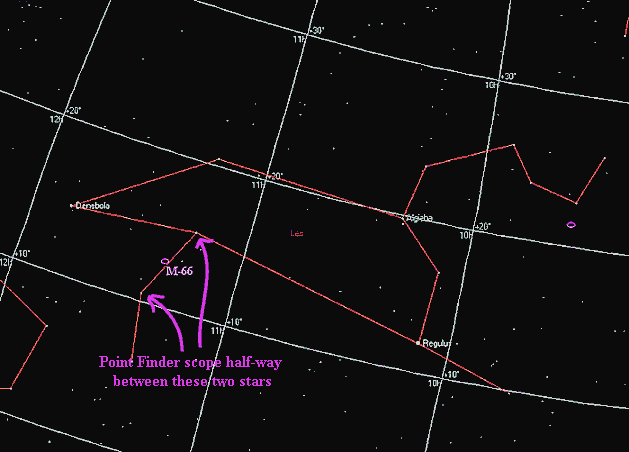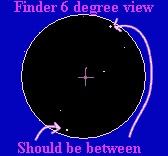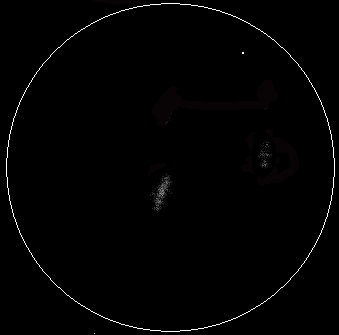

 |
 |
| Rm. N112: Beginning sky navigation. |
This Class has two parts:Using the Planisphere/star map to find stuff and setting up and using a finder scope. They are inter-related and not seperate methods for navagating the night sky. There are other methods and variations of this method that you can learn and use once you understand the basics here.
Look at the outer edge you will see months separated by the days of the months and you will see times of the night along side. Here all you do is match up the time of night you plan to view with the corresponding day of the month. This part goes with both planispheres and magazine charts. Now examine the chart/planisphere and notice that there is a point called the Zenith (planisphere will have the center of rotation brad at that point) this represents the point in the sky that is directly overhead.
Using the Planisphere (or one of the Magazine sky Charts):
Now lets say you are interested in what those bright stars are over to the South East. Hold your planisphere/chart in front of you and rotate The whole planisphere - don't loose your time and date settings) it so that South East (SE) is on the bottom. Now hold up the chart over head and match the bright stars and groupings to the south east with those on the chart. Star patterns (and Planet locations on charts) should be close enough to what you see on the chart to identify what constellations are there. This is where star charts for specific regions now come in.
Note: these charts are accurate at the latitude (+/- 10 degrees) for which they represent because they are intended to help you locate constellation size areas of the sky.
Lets try an example. (good for late October):
You want to find and see the Andromeda Galaxy M31 and maybe see M32 and M101 also. Your star chart shows you that the galaxy(ies) is located in the constellation of Andromeda in the northern part. You (being observant) also notice that Part of the "W" of Cassiopeia points toward one of the brighter stars of Andromeda and that the galaxy is close along that line about 3/4 of the way. But where is Andromeda and where is Cassiopeia with relation to tonight's sky, is it even up tonight when I'll be looking? So we get out our planisphere/magazine chart and set it up for tonight at 10PM. Then looking on the planisphere you find Andromeda and see that it is almost directly overhead a little to the east and your pointer (Cassiopeia) is to the north. You also notice that there is what is called the great Square of Pegasus close by. Going out side at 10PM tonight you pick a direction (Lets say North) and hold the planisphere/chart overhead with North on the chart facing north and look for your land mark star groupings (the "W" (pointer) and the great square). You should be able to find them with relative ease and can now put down the planisphere. Looking at the "W" and finding your pointer you follow an imaginary line to a brighter star (you are now in Andromeda) and then back up along the line so that you are looking 3/4 of the way to that star in Andromeda. This is where you will point your scope and start a gentle sweep. You will with a little patience find and see Andromeda Galaxy
If you have ever tried to point a telescope without a finder of some type, you have missed one of the most frustrating experiences in amateur astronomy. I have spent a long time trying to aim my telescope rifle style at the moon (should be easy enough) by looking along the tube. If it weren't for a few other techniques I used, it seems I never would have found the moon. How can you not find an object as large as the moon you might ask? The moon covers 1/2 degree of sky and looks large when looking at it, but a 1/2-degree spot in the sky is very small. Look at a protractor or compass and see how small a degree is when it is compressed to that size. Using binoculars you can cover 4 to 7 degrees of sky and with them it is fairly easy to just point them and find the moon. This is where a finder scope comes in. Finder Scopes are low powered and usually have cross hairs. The cross hairs in the finder scope should be aligned with the telescope so that when you have an object centered in the cross hairs, then look in the telescope, you should see the object with a low to medium power eyepiece. It is very important to take time to align the finder with the telescope.
Follow these steps to align a finder scope: During the day find and point your telescope at a very small object that is about a block away from you, such the insulator on a telephone pole (make sure it is as centered in the telescopes view as possible). Set your telescope so that it won't move. Now using the screws holding the finder scope to its mount, loosen them a little. Then adjust the screws until the cross hairs are centered on the object your telescope is centered on and the screws are tight. Recheck your telescope to be sure it is still centered at the same place and readjust both if necessary. The closer you set the finder scope the easier it will be to find what you are aiming at.
Finder scopes generally have small apertures (around 24mm). Those that are smaller will not bring in enough light to see anything but the brighter stars. While those that are larger, around 50mm, will be able to find fainter landmark stars (but look silly on a 60mm telescope). A lot of what you are going to be trying to find will be too faint to see through the finder scope. So what you will be doing is, looking at what you want to find on the star charts, noticing groupings of brighter stars that are close, and then finding those groupings of brighter stars in your finder scope to direct you to the faint object.
Here is an example of how to find M66 a galaxy:


View through finder scope and locate your finder stars and estimate where M66 is.
Center finder scope on you estimate.

You found it! (M66 probably does not look like this).
In addition to finder scopes there are reflex finders such as the Telerad. This uses the same technology as is used in fighter jets, HUDs (heads up display). Here you have the advantage of seeing the whole sky with what appears as a bulls-eye projected on the sky. The Bulls-eye gives the advantage of having known degrees projected on the sky. There is no magnification or additional light gathering power advantage with Reflex Finders. There are also pointers that appear to project a red dot on the sky. All of these devices can be adjusted to align with your telescope and are used basically the same way as the finder scope to find stuff. Their main advantage with reflex finders is you see the sky as it is, not upside down or backwards.